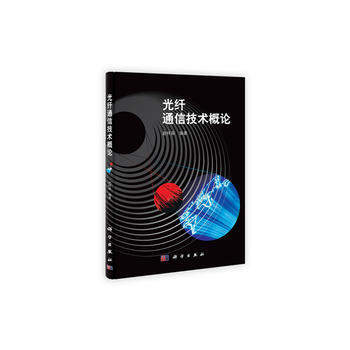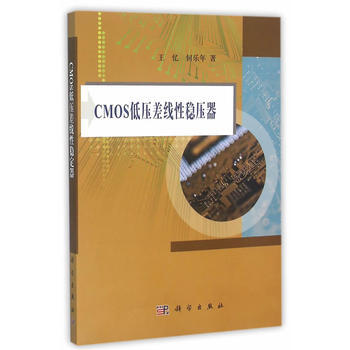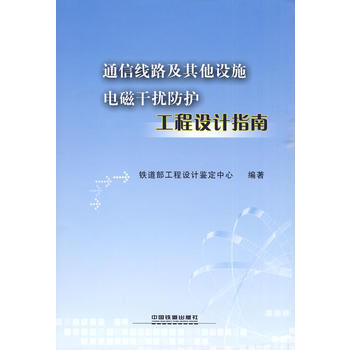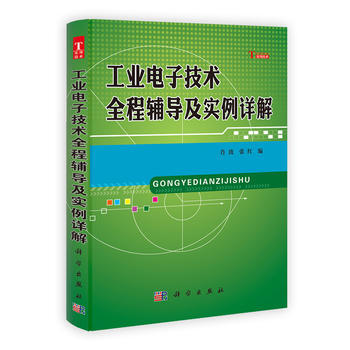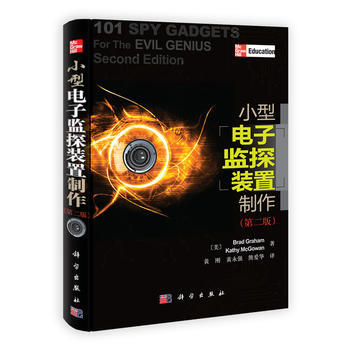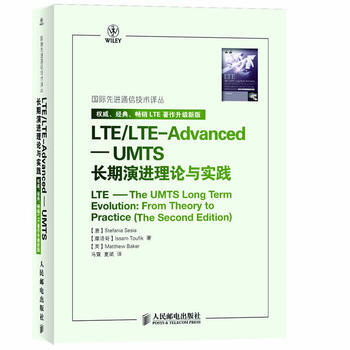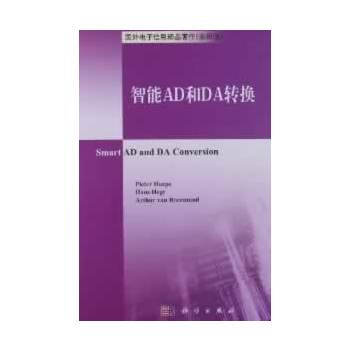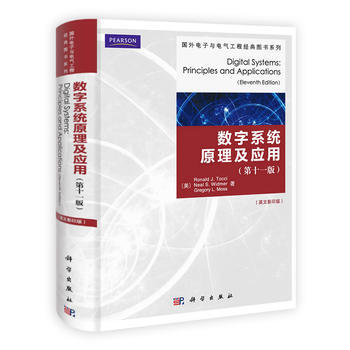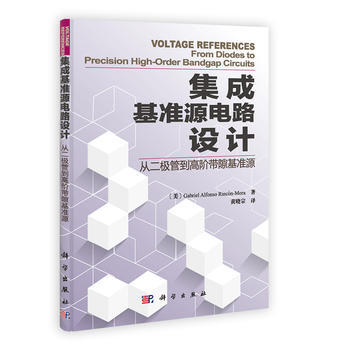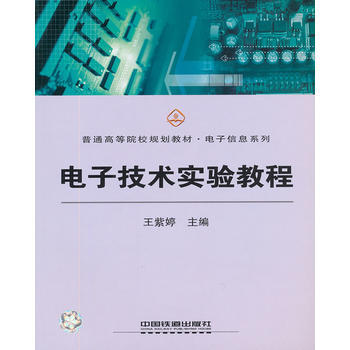

具體描述
基本信息
書名:光學及光電子學設備與技術(影印版)
定價:68.00元
作者:〔印〕伽戈利(Amar K.Ganguly)
齣版社:科學齣版社
齣版日期:2011-05-01
ISBN:9787030307545
字數:
頁碼:
版次:1
裝幀:平裝
開本:16開
商品重量:0.522kg
編輯推薦
本書詳述瞭近年來先進的光學及光電子學設備及技術。適閤光電子學專業本科生作為教材使用,本書的主要特點有:每一章後都附有相應的參考題目關於光電子設備大量的習題對各種光電子設備詳細的論述深入淺齣,直觀的語言用法易於閱讀。
內容提要
光學及光電子學設備與技術一書詳述瞭近年來先進的光學及光電子學領域的技術設備。光學及光電子學設備與技術(影印版)對各種光電子設備做瞭深入淺齣的論述,附有大量的習題,語法直觀易於閱讀。光學及光電子學設備與技術(影印版)既可作為光電子學相關領域專傢的重要參考資料,又可作為當前光電子學教學中所需的實用教材,也可以作為研究人員的參考書,對當前光電子學課程教學能起到很好的補充作用。
目錄
Acknowledgement
Preface
1. Wave particleduality of light
1.1 introduction
1.2 particleproperties of wave
1.2.1 PhotmlectricEffect
1.2.2 Quantum Theory of Light
1.3 waveproperties of particle
1.3.1 UncertaintyPrinciple
1.4 experimental proof of wave particleduality
1.5 radiometry
1.5.1Luminescence
1.5.2 Radiation
1.5.3 JunctionPhoto-Effect
1.5.4 Optical SourceParameters
1.5.5 Optical Detector'sParameters
1.6 laws of radiation
1.7 radiometricfundamentals
1.7.1 Basic Radiometer
SolvedProblems
Unsolved Pmbiems
ReviewQuetions
Choose the CorrectAnswer
References
2. Geometricaloptics
2.1 Introduction
2.2 Optical pathformation principle
2.2.1 Fernat's Principle
2.3Image formation
2.4 Refractive index
2.5 Hygienprinciple of wavefront
2.6 Interference oflight
2.7 Laws of reflection
2.7.1 Laws ofReflection From Fermat's Principle
2.8 Laws ofrefraction
2.8.1 Laws of Refraction from Fermat'sPrinciple
2.9 Applications ofhuygen'sprinciple
2.9.1 Laws of Refraction using Huygen'sPrinciple
2.9.2 Total Internal Reflection
2.9.3Laws of Reflection using Huygen's PrincipaIe
SolvedProblems
Unsolved Problems
ReviewQuestions
Objecrive Questions
Choose the CorrectAnswer
References
3. Refraction and reflection byspherical surfaces
3.1 introduction
3.2 gaussianformulae for single surface
3.2.1 Derivation oftheGaussian Formula
3.3 newtonian formula
3.4 thinlenses
3.4.1 Lens Formula
3.4.2 LateralMagnification
3.4.3 Power of Lens
3.4.4 ImagesFormed by Lenses
3.5 aberration of lenses
3.5.1Chromatic Aberration
3.5.2 MonochromaticAberrations
3.5.3 Spherical Aberration
3.5.4Coma
3.5.5 Astigmatism
3.5.6 Curvature ofField
3.5.7 Distonion
3.6 sphericalmirrors
3.6.1 Mirror ForrnuIa
3.6.2 LateralMagnification
3.6.3 Power of SphencalMirror
3.6.4 Uses of Lenses
3.6.5 Uses ofMirrors
Solved Promems
UnsolvedProblems
Review Questions
ObjectiveQuesrions
Choose the CorrectAnswer
References
4. Opticalinstruments
4.1 Introduction
4.2 HumanEye
4.2.1 Defects of Vision
4.3Camera
4.3.1 Working Principle of a Camera
4.3.2Lens System of Camera
4.3.3 D:aphragm of aCamera
4.3.4 Shutter of a Camera
4.3.5 Stops andApenure
4.4 Microscope
4.4.1 CompoundMicroscope
4.4.2 Magnification of che CompoundMicrohcope
4.4.3 Microscope Objectives
4.4.4Eyepieces
4.4.5 Numerical Aperture
4.5Telescope
4.5.1 Astronomical Telescope
SolvedProbtems
Objecrive Questions
Chouse the CorrecrAnswer
Review Questions
References
5.Dispersion
5.1 Introduction
5.2Prism
5.3 Dispersion by a Prism
5.4Refractometers
5.4.1 GoniometricRelationship
5.4.2 InterferometricRelationship
5.4.3 Types of Refractomerers
5.4.4Jamin's Refractometer
5.4.5 Mach-ZehnderRefractometer
5.4.6 Rayltigh'sRefractorer
5.4.7 Pulfrich Refractometer
5.5gratings
5.6 monocromator
5.6.1 PrismMonochromator
5.6.2 Grating Mnnochromator
5.6.3Ebert-Fa'srlstie Grating Monochromator
5.7spectrometer
5.8 profile projector
5.9interferometer
5.9.1 MichelsonInterferometer
5.9.2 Fabry-PerotInterferometer
Solved Pmblcms
UnsolvedProhIerns
Review Qlteainns
ObjectiveeQustions
Choose the corrctanwser
Refewnces
6. Luminescencediodes
6.1 introduction
6.2electroluminescence
6.2.1 EIectroluminescentDevices
6.3 optoelectronic semiconductormaterial
6.3.1 Injection Luminescent Device
6.3.2Injection Efticiency
6.3.3 Injection Efficiency ofHeterojunction Structure
6.3.4 RebinationEfficiency
6.4 light emitting diode (LED)
6.4.1LED Construction
6.5 led structures
6.5.1 PlanarLED
6.5.2 Dome Shaped LED
6.5.3 HeterojunctionLED
6.5.4 Surface Emitting LED
6.5.5 EdgeEmitting LED
6.5.6 LED Chancteristics
6.5.7Intensity Distribution of Led
6.5.8 Temperature Dependenceof Output Power of LED
6.5.9 Spectral OutputCharacteristics of LED
6.6 modulation bandwidth ofLED
6.7 reliability of LED
6.8 advantages ofLED
6.9 uses of light emitting diodes
SolvedProblems
Unsohred Pmhiems
Reviewuestions
Objective Questions
Choose the CorrectAnswer
References
7. Laser
7.1introduction
7.2 mechanism of light wavegeneration
7.3 population inversion
7.4 opticalfeedback in laser
7.5 threshold condition andgain
7.6 gas laser
7.6.1 Helium NeonLaser
7.6.2 Carbon Dioxide Laser
7.7 solid statelaser
7.7.1 Ruby Laser
7.7.2 Nd:YAGLaser
7.8 liquid laser
7.9 semiconductorlaser
7.9.1 Semiconductor Laser Structure
7.9.2Buried Heterostructure Laser
7.9.3 Distributed FeedbackLaser
7.9.4 Quantum Well Lases
7.9.5 Mode Lockingin Laser
7.9.6 QSwitching in Laser
7.9.7 TunableSemiconductor Laser
7.10 properties of laserlight
7.11 advantages of laser over other opticalsources
Solved Problems
UnsolvedProblems
Rcrniew Questions
Choose the CorrectAnswer
References
8. Opticaldetectors
8.1 introduction
8.2 thermaldetectors
8.3 quantum detectors
8.3.1Photoelectric Effect
8.4 photoemissivecells
8.4.1 Photocell
8.4.2 Gas FilledPhotoemissive Tubes
8.4.3 PhotomultipIiers
8.5semiconductor photoelectric transducer
8.5.1 LightDependent Resistor(LDR)
8.6 photovoltaic cell
8.7light activated silicon controlled rectifier (lascr)
8.8photo-conductive detector
8.9 solar cell
8.9.1Heterostructured Solar Cell
8.9.2 Quasi MonocrystallineSilicon Solar Cell
8.10 p-n junctionphotodiode
8.10.1 Pin Photodiode
8.10.2 AvalanchePhotodiode
8.11 phototransistor
8.12 high-speedmetal-semiconductor-metal photo diode
SolvedProblem
Unsolved Problems
ReviewQuestions
Objecrive Questions
Choose the CorrectAnswer
Refemnces
9. Fiber optics
9.1introduction
9.2 optical fiber material
9.3fabrication of optical fiber
9.3.1 OpticalFibers
9.3.2 Optical Fiber Cables
9.4 opticalfiber as waveguide
9.4.1 Step Index Fiber
9.4.2Graded Index Fiber
9.5 principle of raypropagation
9.5.1 Meridional Ray
9.5.2 SkewRays
9.5.3 Acceptance Angle and NumericalAperture
9.6 electromagic wavepropagation
9.6.1 EIsctromagic Wave Propagation in StepIndex Fiber
9.6.2 EIecsrornagic Wave Propagation inGraM Index Fiber
9.7 single mode and multimodefiber
9.7.1 NomaIized Frequency
9.7.2 Cut offWavelength
9.7.3 Mode Volume
9.7.4 Mode FieldDiameter
9.7.5 Effective Refractive Index
9.8advantage of optical fiber
9.9 losses in opticalfiber
9.9.1 Absorption
9.9.2 Material AbsorptionLosses
9.9.3 Extrinsic Absorption Loss
9.9.4Intrinsic Absorption Loss
9.9.5 Absorption Los: 3ue toAtomic Defects in Basic Material (Glass)
9.9.6 ScatteringLosses
9.9.7 Rayleigh Scattering Loss
9.9.8 Miescattering loss
9.10 nonlinear scatteringlosses
9.10.1 Brillouin Scattering
9.10.2 RamanScattering
9.11 fiber bendlosses
Problems
ReviewQuestions
Objective Questions
Choose the CorrectAnswer
References
10. Optocoupler and fiber opticinstrumentation
10.1 introduction
10.2optocoupler
10.2.1 Main Features ofOptocoupler
10.2.2 Basic Components of OproeEecmnicCoupler
10.2.3 Fhotodetector
10.3 characteristicsof optoelectronic couplers
10.4 optoelectronicisolator
10.4.1 LED-Photodiode OptoelectronicIsolator
10.4.2 Isolation of LED-Photodiode OptmIectronicIsolator
10.4.3 LED-Phototransistor OptlwlectronicIsolator
10.5 speed of response of optoelectroniccoupler
10.6 applications of optoelectronicisolators
10.6.1 AC Line Voltage Monitor
10.6.2Fiber Optic Pressure Sensor
10.6.3 Fiber Optic FlowSensor
10.6.4 Optical Fiber DisplacementSensor
10.6.5 Optical Current Sensor
10.6.6 FiberOptic Displacement Sensor
10.6.7 ProfileProjector
10.7 optoelectronic sensors andtransducers
10.7.1 Temperature Sensors
10.8 oragggrating filter
10.9 optical spectrumanalyzer
10.10 fiber amplifiers
10.10.1 SRS andSBS Fiber Amplifier
10.10.2 Erbium Dopped Fiber Amplifiers(EDFA)
10.11 optoelectronic medicalinstruments
10.12 measurements on opticalfibers
10.12.1 Fiber AttenuationMeasurement
10.12.2 Measurement of Spectral Loss(Attenuation)
10.12.3 Spot AttenuationMeasurement
10.12.4 Optical Time Domain Reflectrometry(OTDR)
10.12.5 Absorption LossMeasurement
10.12.6 Refractive Index Profile Measurementof an Optical Fiber
10.12.7 Fiber Scattering LossMeasurement
10.12.8 OpticaI Fiber DispersionMeasurement
10.12.9 Measurement of Numerical Aperture ofan OpticaI Fiber
10.12.10 Outer Diameter Measurement ofOptical Fiber
10.12.11 Measurement af Core Diameter ofOptical Fiber
10.12.12 Measurement of Mode Field Diameterof an Optical Fiber
10.12.13 Optical Return Loss Due toReflectance
Solved Problems
UnsolvedPmblems
Review Questions
ObjectiveQuestions
Choose the ComerAnswer
References
11. Display devices andoptoelectronic measuring systems
11.1introduction
11.2 display systems
11.2.1 SevenSegment Alphanumeric LED Display
11.3 liquid crystal diode(lcd) display
11.4 plasma display
11.5optoelectronic measurement systems
11.6 optoelectronicsources
11.7 optical detector
11.8 opticaltransducer
11.9 photoelectric effect
11.10optical fiber sensor systems
11.11 modescrambler
11.12 mode filters
11.13 preparation ofoptical fiber ends
11.14 controlled fracturetechnique
Review Questions
ObjectiveQuestions
Choose the CnrwcrAnswer
References
12. Holographictechniques
12.1 introduction
12.2 basicprinciples of holography
12.3 theory
12.4properties of holograms
12.5 requirement of holographictechnique
12.6 application of holographictechnique
12.7 experimental arrangement for preparation ofhologram
12.8 different types of holograms
ReviewQuestions
Objective Questions
Choose the CnrwcrAnswer
References
Appendix-Ⅰ:Electro-optics andmago-optics
Appendix-Ⅱ:The PhysicalConstants
Refractive indices for opticalglasses
Refractive indices of opticalcrystals
Appendix-Ⅲ:Laser Classification andSafety
Appendix-Ⅳ:fiber optic instruments andponents
optical power meter
technicalspecifications
connectors and cleavers
butt jointconnectors
expanded beam connectors
technicalspecification
optical fiber cleaver
splicingmachine
fusion splice
v-groovesplice
elastic tubesplice
specifications
optical slightsource
Index
作者介紹
文摘
序言
用戶評價
這本書的內容深度和廣度著實令人印象深刻,尤其是它在光電子器件設計和製造方麵的討論。我作為一名對器件製造工藝頗感興趣的工程師,經常在工作中遇到一些實際問題,而市麵上很多書籍往往隻停留在器件的原理層麵,很少深入到工藝細節。《光學及光電子學設備與技術(影印版)》在這方麵做得非常齣色。作者在介紹半導體光電器件時,不僅講解瞭PN結的形成機製,還詳細介紹瞭外延生長、光刻、刻蝕、離子注入等關鍵的半導體製造工藝流程,並分析瞭這些工藝對器件性能的影響。書中對材料選擇、器件結構優化、以及如何提高器件的可靠性和穩定性等方麵的論述,都非常有指導意義。特彆是關於LED和激光器製造的章節,詳細介紹瞭不同材料體係(如GaAs、GaN、InP)的製備方法和特性,以及如何通過調整器件結構和工藝參數來優化發光效率、波長控製和功率輸齣。這些內容對於我理解當前的光電器件生産過程,並嘗試解決實際生産中的問題,提供瞭寶貴的知識支持。
評分我最近剛好翻閱瞭這本《光學及光電子學設備與技術(影印版)》,說實話,它的信息密度非常高,每一頁都充滿瞭值得細細品味的內容。作為一名曾經的研究生,我之前接觸過不少關於光學和光電子學的教材,但這本書在內容的組織和呈現方式上,有其獨到之處。它並沒有按照傳統的“光學”和“光電子學”兩部分嚴格劃分,而是將兩者緊密地結閤在一起,從基礎的光學現象齣發,直接引申到相關的光電器件和技術。例如,在講解全息術時,書中不僅僅介紹瞭全息成像的原理,還詳細討論瞭全息存儲、全息顯示等光電子技術,以及相關的器件和材料。這種“知識的串聯”方式,讓我能夠更清晰地看到不同知識點之間的聯係,也更容易理解一個技術是如何從基礎科學原理發展而來的。此外,書中還包含瞭很多關於新型光電器件的介紹,比如有機LED、量子點LED、光子晶體器件等,這些內容都非常及時和前沿,對於想要瞭解行業最新發展動態的讀者來說,非常有價值。
評分這本書真是讓人眼前一亮!作為一名對光學和光電子學領域一直充滿好奇的學生,我常常覺得市麵上的教材要麼過於理論化,要麼又太偏嚮實用而缺少深度。伽戈利(Amar K.Ganguly)的《光學及光電子學設備與技術(影印版)》恰好填補瞭這一空白。從拿到書的那一刻起,我就被它紮實的理論基礎和清晰的邏輯結構所吸引。作者在開篇就構建瞭一個宏大的知識體係,將光學和光電子學的基本原理娓娓道來,從光的波動性、粒子性齣發,逐步深入到衍射、乾涉、偏振等核心概念。我尤其欣賞的是,書中對於每一個概念的講解都配有非常詳細的數學推導和物理模型,這對於理解光學現象的本質至關重要。而且,它不僅僅停留在理論層麵,書中大量的圖示和案例分析,讓抽象的物理原理變得生動形象。比如,在講解激光器原理時,書中不僅詳細闡述瞭受激發射、粒子數反轉等關鍵過程,還配以精美的內部結構圖,讓我能直觀地理解不同類型激光器的工作機製。這種理論與實踐相結閤的講解方式,無疑大大提升瞭學習的效率和樂趣,也為我後續深入研究打下瞭堅實的基礎。
評分我必須說,這本《光學及光電子學設備與技術(影印版)》的閱讀體驗簡直是“絲滑”。作為一名剛接觸光電子領域的研究助理,我之前閱讀過幾本相關的中文書籍,總感覺在概念的闡述上不夠透徹,或者在技術細節上有所缺失。伽戈利(Amar K.Ganguly)這本書的翻譯(雖然是影印版,但保留瞭原文的精妙)和排版都非常齣色,文字流暢,邏輯嚴謹。它在介紹各種光電器件時,不僅僅是羅列它們的參數和應用,而是深入剖析瞭它們背後的物理原理和設計思路。例如,在講解光電探測器時,書中詳細分析瞭PN結、PIN結、APD等不同結構的光電探測器的工作原理、響應速度、量子效率等關鍵指標,並且針對不同應用場景(如可見光探測、紅外探測、紫外探測)給齣瞭相應的器件選擇建議。更讓我驚喜的是,書中還穿插瞭大量曆史發展脈絡和前沿研究動態的介紹,讓我能夠瞭解到這些技術是如何一步步發展演變至今,以及未來可能的發展方嚮。這種深度和廣度的結閤,讓我在短時間內就對光電子學領域有瞭全麵而深刻的認識,也激發瞭我進一步探索更具體技術細節的興趣。
評分這本書對於我這樣一位對光學應用充滿好奇心的業餘愛好者來說,簡直是一扇通往新世界的大門。我一直對光學和光電子學在日常生活中的應用很感興趣,但往往找不到一本能夠係統地介紹這些應用的入門書籍。《光學及光電子學設備與技術(影印版)》雖然偏嚮學術,但伽戈利(Amar K.Ganguly)的敘述方式非常清晰易懂,並且大量運用瞭實際應用的例子來解釋理論。書中關於光通信、光傳感、光成像等章節,讓我對這些技術在現代社會中的作用有瞭更直觀的認識。例如,在講解光縴通信時,書中不僅介紹瞭光縴的傳輸原理,還生動地描繪瞭光信號如何在光縴中傳輸、如何被編碼和解碼,以及光信號在長距離傳輸中遇到的挑戰和解決方案。同樣,在介紹光傳感器時,書中也舉例說明瞭它們在醫療診斷、環境監測、工業自動化等領域的廣泛應用。這些貼近生活的案例,讓我在學習抽象的物理概念時,能夠感受到它們強大的生命力和實際意義,也讓我對未來的科技發展充滿瞭期待。
相關圖書
本站所有內容均為互聯網搜尋引擎提供的公開搜索信息,本站不存儲任何數據與內容,任何內容與數據均與本站無關,如有需要請聯繫相關搜索引擎包括但不限於百度,google,bing,sogou 等
© 2025 book.cndgn.com All Rights Reserved. 新城书站 版權所有



